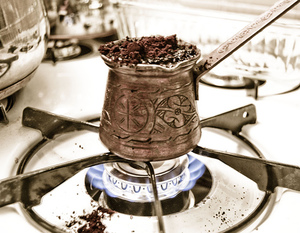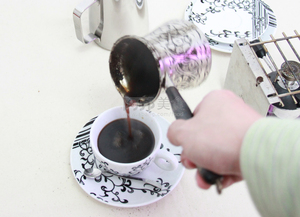Coffee Culture Basics Common Sense Finely ground Turkish coffee

There is a Turkish proverb: "drink your cup of Turkish coffee, remember your friendship for forty years." A cup of Turkish coffee with cloves, cardamom and cinnamon is full of fragrance when it is hot. No wonder Arabs praise it as "musky and fascinating."
Turkish coffee, also known as Arabica coffee, is the ancestor of European coffee, which has a history of 700 to 800 years. The reason why we have to mention Turkish coffee when it comes to coffee is that no matter from the perspective of Islam or Christianity, the origin of coffee is in the remote and mysterious mountains of the Middle East. Coffee was born in Turkey in the 16th century, began to be commercialized, and quickly spread to continental Europe. Turkish coffee is still popular in Greece, Eastern Europe, the Middle East, North Africa and other places, and still maintains the mystery of early religious rituals. It is said that in Turkey, it is extremely noble to make a cup of traditional Turkish coffee for guests, and some even bathe and fast in advance.
In Turkey, inviting others to have coffee at home represents the most sincere respect of the host. Therefore, in addition to praising the mellow taste of the coffee, guests should also remember that they should not drink water even if they are full of dregs, because it implies that the coffee is not good. Turks drink coffee slowly, and they even have a set of exquisite "coffee ceremony", just like the Chinese tea ceremony. When drinking coffee, not only to burn incense, but also sprinkle spices, smell incense, a dazzling variety of coffee pots, but also full of Arabian Nights style. A cup of Turkish coffee with cloves, cardamom and cinnamon is full of fragrance when it is hot. No wonder Arabs praise it as "musky and fascinating."
Turkish coffee is a kind of coffee that uses the original brewing method, and many Turks, especially women, like to use the coffee residue marks left by Turkish coffee to predict the luck of the day. The Turks say that coffee is the black enemy of sleep and love, in other words, sleep and love can be sacrificed for coffee.
The way of drinking Turkish coffee is the most primitive, and the local people drink Turkish coffee without sugar. The first feeling of drinking is sticky, like syrup. The second is suffering, which can be remembered for a long time. In the middle of the drink, you will feel the dregs, but do not stop, drinking together with the dregs can really be regarded as drinking Turkish coffee. The feeling of drinking dregs is unforgettable, neither bitter nor astringent. There is an unspeakable experience that you must taste before you can fully understand it.
In addition, there is an interesting local custom that if a man finishes his coffee and puts the empty cup back on the tray in the girl's hand, it shows that he is willing to marry her. British Crown Prince Charles paid a whirlwind visit to Marding in eastern Turkey, and the host arranged a variety of visits. During the break, a beautiful young local woman brought Charles traditional local coffee. As soon as Charles took a taste, he heard the governor of Malding remind him of the local customs. Hearing this, Charles returned the cup with more than half a cup of coffee to the woman and said, "you almost became a princess of England."
How to make Turkish coffee
The coffee beans are deeply roasted and ground into a very fine powder. Turkish coffee requires the finest of all kinds of bubble methods, requiring very fine grinding, and the intuitive standard is to be finer than flour. Then mix the spices such as cloves, cardamom and cinnamon. Then put 100ml of cold water in the Turkish coffee pot. Then add about 10 grams of coffee powder. 100ml water + 10g powder is the golden ratio of a cup of coffee.


After the raw material is added, it should be heated and stirred constantly. Stir gently and slowly to avoid dispersing the powder layer of the liquid surface (to avoid breaking slag), so as to avoid excessive extraction. Just before boiling, there was a layer of golden foam on the surface. The foam gradually increased and surged up quickly. Immediately, the pot was removed from the fire. After several times of boiling, the coffee became thicker and thicker, but not until the water was boiled in half. When the coffee grounds precipitate to the bottom, pour out the clarified coffee liquid on the top layer. Sometimes lemon or honey can be added. Such a delicious cup of Turkish coffee is ready.

Important Notice :
前街咖啡 FrontStreet Coffee has moved to new addredd:
FrontStreet Coffee Address: 315,Donghua East Road,GuangZhou
Tel:020 38364473
- Prev

Civet Coffee Luwak Coffee
The legendary Kopi Luwak civet coffee, brought by a colleague from Indonesia. It's only 100 grams. It is said that civets like to eat coffee fruits grown by Robusta. The recommended brewing temperature is 80 degrees Celsius, which makes sense. I have tried both high and low water temperature. If the water temperature is too high, there will be an obvious fishy smell. The water temperature is too low and too light, and the taste of 80 degrees Celsius is the most suitable. In the office, you have to
- Next

The variety of fancy coffee, flawless cappuccino.
The timeless classic latte is a classic blend of Italian espresso and milk. Italians also like lattes as breakfast drinks. In the Italian kitchen in the morning, coffee and milk are usually brewed on the sunlit stove. Italians who drink lattes do not so much like espresso as milk.
Related
- Beginners will see the "Coffee pull flower" guide!
- What is the difference between ice blog purified milk and ordinary milk coffee?
- Why is the Philippines the largest producer of crops in Liberia?
- For coffee extraction, should the fine powder be retained?
- How does extracted espresso fill pressed powder? How much strength does it take to press the powder?
- How to make jasmine cold extract coffee? Is the jasmine + latte good?
- Will this little toy really make the coffee taste better? How does Lily Drip affect coffee extraction?
- Will the action of slapping the filter cup also affect coffee extraction?
- What's the difference between powder-to-water ratio and powder-to-liquid ratio?
- What is the Ethiopian local species? What does it have to do with Heirloom native species?

